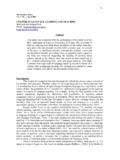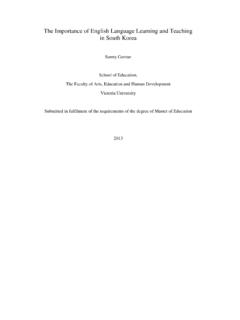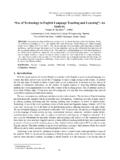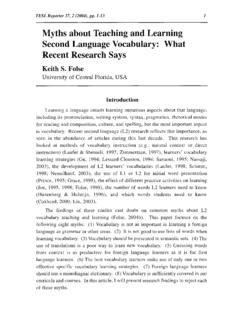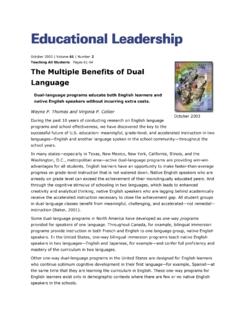Transcription of Issues in Language Learning Strategy Research and Teaching
1 Electronic Journal of Foreign Language Teaching 2004, Vol. 1, No. 1, pp. 14-26 Centre for Language Studies National University of Singapore Issues in Language Learning Strategy Research and Teaching Anna Uhl Chamot The George Washington University Abstract Learning strategies are the thoughts and actions that individuals use to accomplish a Learning goal. Extensive Research has identified the Learning strategies used by students of a variety of second and foreign languages and a somewhat smaller body of Research has documented the effectiveness of helping less successful lan-guage students improve their performance through Learning Strategy instruction. This article discusses current Issues in Language Learning Strategy Research that affect teachers and learners of foreign languages.
2 These Issues include: identification procedures of Learning strategies, terminology and classification of strategies, the effects of learner characteristics on Strategy use, the effects of culture and context on Strategy use, explicit and integrated Strategy instruction, Language of instruction, transfer of strategies to new tasks, and models for Language Learning Strategy instruction. These eight Issues are explored through a discussion of existing re-search that illumines the Issues . Suggestions are presented for future Research on Issues that have not yet been thoroughly explored. 1 Introduction Learning strategies are the conscious thoughts and actions that learners take in order to achieve a Learning goal.
3 Strategic learners have metacognitive knowledge about their own thinking and Learning approaches, a good understanding of what a task entails, and the ability to orchestrate the strategies that best meet both the task demands and their own Learning strengths. An area of basic Research in second Language acquisition is the identification and description of Learning strategies used by Language learners and the correlation of these strategies with other learner variables such as proficiency level, age, gender, motivation, and the like (Chamot & El-Dinary, 1999; El-Dib, 2004; Green & Oxford, 1995; Oxford & Burry-Stock, 1995). Current re-search is also investigating the effect of the task itself on the selection and use of Learning strate-gies, including the influence of the target Language (Chamot & Keatley, 2004; Oxford, Cho, Leung & Kim, 2004).
4 Applied Research on Language Learning strategies investigates the feasibility of helping students become more effective Language learners by Teaching them some of the Learning strategies that descriptive studies have identified as characteristic of the good Language learner (Rubin, 1975; 1981; Stern, 1975). This paper first examines a number of current Issues in Language Learning Strategy Research that have emerged from earlier descriptive and intervention Research and discusses how these Issues affect teachers and learners of second and foreign languages. Finally, suggestions are made for needed future Research in discovering how Language Learning strategies can assist students in be-coming more effective second Language learners.
5 Issues in Language Learning Strategy Research and Teaching 152 Issues in Language Learning Strategy Research The preponderance of Research on Language Learning strategies has been descriptive, as re-searchers have sought to discover what Learning strategies are reported by learners of different languages. The Issues that arise from this body of Research are: identification procedures of learn-ing strategies, terminology and classification of strategies, the effects of learner characteristics on Strategy use, and the effects of culture and context on Strategy use. While less extensive, Strategy intervention Research has also suggested important Issues related to instruction such as: explicit and integrated Strategy instruction, Language of instruction, transfer of strategies to new tasks, and models for Language Learning Strategy instruction.
6 This paper explores these eight Issues by examining existing Research that illumines the Issues and by suggesting Research needed on Issues that have not been thoroughly explored. Identification of Language Learning strategies Language Learning strategies are identified through self-report. Although self-report may be in-accurate if the learner does not report truthfully, it is still the only way to identify learners mental processing. As Grenfell and Harris (1999) have so aptly stated: [..] it is not easy to get inside the black box of the human brain and find out what is going on there. We work with what we can get, which, despite the limitations, provides food for thought [..] (p. 54) Learning strategies are for the most part unobservable, though some may be associated with an observable behavior.
7 For example, a learner could use selective attention (unobservable) to focus on the main ideas while listening to a newscast and could then decide to take notes (observable) in order to remember the information. In almost all Learning contexts, the only way to find out whether students are using Learning strategies while engaged in a Language task is to ask them. Verbal report data are used to identify Language Learning strategies because observation does not capture mental processes (Cohen, 1998; O Malley & Chamot, 1990; Rubin, 1975; Wenden, 1991). Researchers have asked Language learners to describe their Learning processes and strategies through retrospective interviews, stimulated recall interviews, questionnaires, written diaries and journals, and think-aloud protocols concurrent with a Learning task.
8 Each of these methods has limitations, but each provides important insights into unobservable mental Learning strategies. In retrospective interviews, learners are asked to describe what they were thinking or doing during a recently completed Learning task (see O Malley & Chamot, 1990). The limitation is that students may forget some of the details of their thought processes or may describe what they per-ceive as the right answer. A stimulated recall interview is more likely to accurately reveal stu-dents actual Learning strategies during a task because the student is videotaped while performing the task, and the interviewer then plays back the videotape, pausing as necessary, and asking the student to describe his or her thoughts at that specific moment during the Learning task (see Rob-bins, 1996).
9 The most frequent and efficient method for identifying students Learning strategies is through questionnaires. The limitations are that students may not remember the strategies they have used in the past, may claim to use strategies that in fact they do not use, or may not understand the Strategy descriptions in the questionnaire items. For these reasons, some studies have developed question-naires based on tasks that students have just completed, reasoning that students will be more likely to remember and to report accurately if little time has elapsed (see Chamot & El-Dinary, 1999; Chamot & K pper, 1989; Ellis & Sinclair, 1989; Fan, 2003; Kojic-Sabo & Lightbown, 1999; Na-tional Capital Language Resource Center [NCLRC], 2000a, 2000b; O Malley & Chamot, 1990; Oxford et al.)
10 , 2004; Ozeki, 2000; Rubin & Thompson, 1994; Weaver & Cohen, 1997). The limita-Anna Uhl Chamot 16tions of this approach are that, to date, there has been no standardization of either tasks or follow-up questionnaires, so that it is impossible to make comparisons across studies. The greatest numbers of descriptive studies have utilized a questionnaire developed by Oxford (1990), the Strategy Inventory for Language Learning (SILL). This instrument has been used ex-tensively to collect data on large numbers of mostly foreign Language learners (see Cohen, Weaver & Li, 1998; Nyikos & Oxford, 1993; Olivares-Cuhat, 2002; Oxford, 1990; 1996; Oxford & Burry-Stock, 1995; Wharton, 2000). The SILL is a standardized measure with versions for students of a variety of languages, and as such can be used to collect and analyze information about large num-bers of Language learners.




